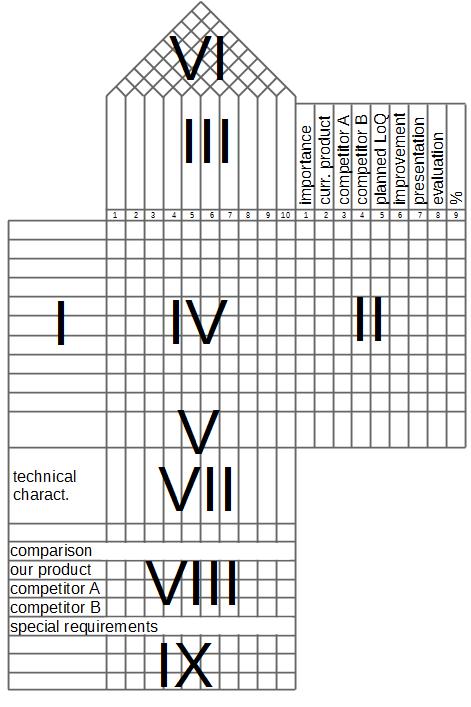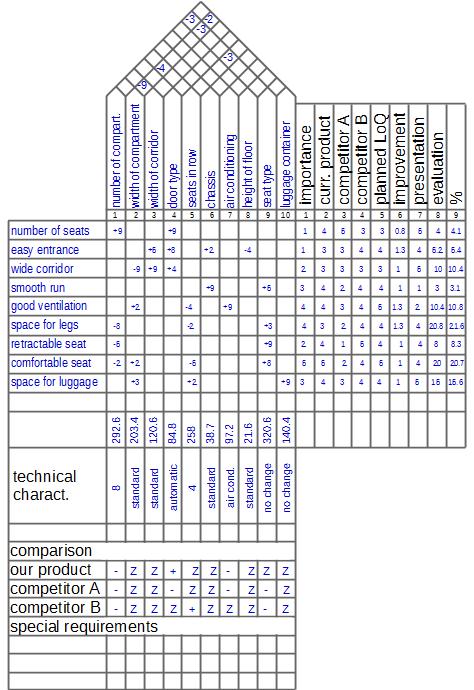Quality Function Deployment
| Quality Function Deployment |
|---|
| See also |
Quality Function Deployment (QFD) is also known as House of Quality, due to characteristic appearance of analytic matrix. It was first used in 1972 in Japan, in the yard belonging to Mitsubishi. After a few years, it gained popularity in the United States, where it was used successfully in plants of Ford and General Motors, and later at Digital Equipment, Hewlett-Packard, AT&T and ITT.
Purpose of QFD
The purpose of QFD is to translate the needs and expectations of the audience into the specifications of product or service. Production on an industrial scale prevents direct contact with the target audience. There is a number of methods of indirect contact, including interviews, surveys, tests. A significant problem for product designers is a lack of customers' expertise. They are usually not able to determine the technical parameters of products. For example, only few customers of drills know how many revolutions per minute should it perform. Most of them think probably: the more the better. Increasing pressure on reducing design costs and shorten its duration meant that there was a need for a method that would make it possible to translate the conscious and unconscious customer requirements into technical specifications, taking into account technological capability, the degree of importance of individual characteristics to the customer and relationships between them. The answer to this need has become the Quality Function Deployment method.
How to build QFD matrix
The main element analytical matrix is known as the house of quality (Fig. 1). It consists of nine sections:
- Customer requirements
- The degree of importance of each of the requirements together with comparative assessment of competing companies.
- The technical characteristics(design, technology) product.
- The link between the needs of the recipient and technical characteristics.
- Rating the technical characteristics.
- Degree of correlation between technical characteristics.
- Values desirable for each technical characteristics.
- Technical comparative assessment.
- Special requirements relating to safety, government regulations, service, etc.
Customer requirements (What?)
In Part I the needs and expectations of the client should be placed (the answer to the question: what?). They are obtained from market research, and use non-technical language, using terms that are used by the customer. This field of practical applications of the method includes dozens, and often more than 100 requirements.
Degree of importance (Why?)
The second part, on the right side of the diagram, allows to determine the significance of needs (question: why?). This part consists of several columns:
- The rank of individual requirement; how important it is for customers. Ranking scope can be defined individually, ex. from 0 to 5, from 0 to 20, etc.
- The second column shows how customers evaluate the fulfilment of the requirement in the tested product (if we already have a product, e.g. older make).
- The next one or more columns presents the grades obtained by the products of competitors.
- Planned level of quality. The assessment of customers that the organization wants to achieve in future for its product
- Indicator of improvement (planned level of quality divided by current customer evaluation in column two).
- Possibility of presenting feature to the customer (is it easily visible or can be unnoticed by customer). Scale from 1.0 to 2.0 usually.
- To finally answer how it will be important modification of the characteristic ratio shall be calculated by multiplying the values of the first column, sixth (indicator of improvement) and seventh (possibility of presentation).
- The last column shows the same indicator in a percentage scale for an easier comparison of the features.
Technical characteristics (How?)
The first two parts of the scheme comply with experts in marketing and sales. However, when filling the third sector engineers are required. To every customer requirement one or more technical characteristics of the product should be assigned. We ask the question: how?
Requirements vs. specification
The fourth part links customer requirements with technical characteristics. It is easy to notice that some requirements may have a stronger effect on the characteristics and other weaker. It may also happen the opposite effect, as in the case of the aforementioned drill - the requirement "a sure and comfortable grip" is inversely correlated with trait "vibes". The strength of the correlation recorded numbers from -9 to +9.
Rating the technical characteristics (Which?)
The fifth part answers the question which? It seeks to obtain information on mutual validity of product characteristics. For this purpose, a simple formula is used:
where
- correlation of requirement i and feature j
- percentage ratio for the requirement i (it was calculated in the second part, column 9)
The result is entered in both the numeric value, as well as a percentage scale.
Correlation between technical characteristics
Part sixth of the matrix has form of a triangle. It serves the presentation of correlations between technical features. It may turn out that the improvement in one parameter will affect the other, for example. "Number of revolutions" may be negatively correlated with "noise". The values are assigned to the same extent as in the fourth part (-9 to +9).
Desirable values
Seventh part contains the numerical values that are assumed for the modified product. You can also refer to standards or other acts. If the requirements and characteristics are plentiful and additionally they exhibit a negative correlation, filling this part becomes extremely difficult and requires a lot of compromises and decision-making at the highest level.
This data is used in part eight, which aims to compare the expected level of quality with existing competition. Additional requirements (legal, environmental, etc.) are recorded in part nine.
Chain of QFD matrices
Presented a conduct is only the first step to create a new product, called product planning. The entrance to the next step (that is data for the first part of a quality house) - to develop the project - will use technical features and their parameters as an input and result with data regarding the components of the product. The third step is to plan the process and the result of it are technological operations. Fourth, production planning, allows to determine the production requirements. It is possible to build the following matrices, until the lowest level of design of all elements relevant to a new product.
J. Sikorski lists the following benefits of using this method:
- Creation of a single organizational structure,
- Facilitate checks on compliance with the work schedule.
- Initiating collaborative forms of work,
- Breaking down barriers between departments,
- Flow of information about customer expectations through the entire structure of the company,
- Accurate diagnosis of the hierarchy of customer expectations,
- Ability to anticipate the level of their performance,
- Increase the company's potential in terms of full implementation of the requirements.
- Business decisions based on accumulated knowledge,
- Avoiding many of the costs and loss of time.
Example of QFD
To illustrate the QFD, Figure 2 shows the application of the method on the rail passenger car. Table 1 shows the properties of the product and the two competitors. An example has been greatly simplified, since both the number of requested characteristics and technical performance in practice are much greater.
Table 1. Performance characteristics of the rail passenger car
| Feature | Current product | Competitor A | Competitor B |
|
the number of compartments |
9 | 10 | 9 |
|
number of seats in a row |
4 | 4 | 3 |
|
type of chair |
seat retractable one stage, profiled | bench, not retractable
Profiling |
seat retractable two stages, not profiled |
|
space for luggage |
4 shelves, tables 4 | 4 shelves, 2 tables | 2 shelves, tables 4 |
|
ventilation |
Heating controlled window opens | central heating, window open | air conditioning, tilt casement |
|
front door |
opened manually | opened manually | opened automatically. |
References
- Chan, L. K., & Wu, M. L. (2002). Quality function deployment: A literature review. European Journal of Operational Research, 143(3), 463-497.
- Matzler, K., & Hinterhuber, H. H. (1998). How to make product development projects more successful by integrating Kano's model of customer satisfaction into quality function deployment. Technovation, 18(1), 25-38.
- QFD Tutorial
- QFD Institute
- QFD free templates for Excel
Author: Slawomir Wawak




